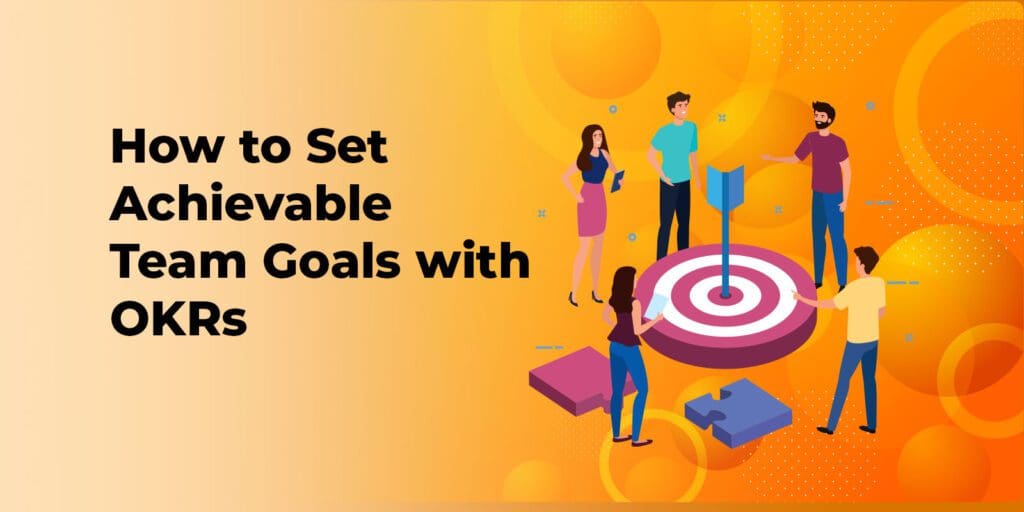Table of Contents
How to Set Achievable Team Goals with OKRs
The Objective and Key Results method successfully helps businesses set goals and achieve them. When a company sets team goals with OKRs, it involves the entire group, leading to transparent decision-making processes. The objective sets the direction for the goal and the key results show the progress being made towards achieving this objective.
This goal-setting framework helps leaders outline a structure around a goal that can be followed by the entire company, making the goal achievable and trackable. Although the objective is important, the recipe for success lies in how well-aligned and motivated every level of the organisation feels about the goal.
In this blog, let’s take a look at why setting team goals are important and how the OKR framework helps in informing a team what their goals are and what are the right actions needed to achieve company goals.
Setting Team Goals for Success
Every successful leadership relies on a cooperative and reliable set of team made of dedicated employees as the backbone of the organisation. Most successful organisations in the modern corporate world thrive because of their goal-driven and analytics-oriented mindset. They set goals to scale their performance and steer the organisation toward its long-term vision.
Team goals refer to performance objectives that demand everyone’s contribution. Thus, inclusivity and accountability are the key motivators for setting team goals. The most successful team goals for success are co-created by discussing or involving the team members, and these high-level goals are aligned with the larger organisational goals.
Team goals tend to be different from the goals set for personal reasons. They have a purpose and direction that consider the overall well-being of both the employees and the organisation, thereby promoting accountability. According to The Management of Organizations, setting team goals in a company environment has four main benefits-
- Delivering direction and supervision
- Streamline the planning of execution of company goals
- Encouraging and inspiring employees
- Helping assess and control performance
Why is the OKR framework Important for Setting Team Goals?
OKRs as a collaborative management methodology help a team drive forward by bringing clarity towards achieving the objectives. It enhances focus, promotes transparency and outlines the top priorities of the organisation. Thus, company OKRs become the grounding point for the individual, team, and organisational initiatives. An example of company OKR would look like this:
Objective
Increase revenue from the new range of Aloe Vera products.
Objective Description
Promote more natural skin care products for appearing more ‘green’ and creating a vegan audience.
Key Result 1
Launch three new products by the end of the quarter
Key Result 2
Succeed in achieving $2 million in sales from new products within 8 months
Key Result 3
Get 10% more positive customer reviews on the website and increase website traffic by 50%
In the above OKR approach, everyone from the sales and marketing team to the web developers is involved. The direction provided by the objective followed by the measurable key results eases the employees into setting individual objectives as well to align with the larger team goals. Thus, setting team goals with OKRs help teams in the following manner:
- Provide clarity and focus: by establishing specific and measurable goals, team members will have a clear grasp of what they are working towards. Through this, achieving general company objectives like growing company revenue and increasing customer retention and growth becomes easier to achieve.
- Avoid confusion: Team goals hand out clear objectives that avoid any misunderstandings. Since each member can be held accountable for their specific tasks and outcomes, it builds trust among the employees and they feel a sense of ownership over their actions
- Encourage overall team involvement: OKRs function successfully as a team-based goal-setting methodology. The objective and quantifiable metrics set in the OKR framework can help a team to harmonise their activities, align with stakeholders, and act less selfishly without just their individual performance targets in mind.
Setting Team Goals that Align with the Bigger Picture
Setting OKRS at the individual contributor level can sometimes lead to failure since asking the employees to outline their objectives and key results can lead to the creation of easy targets. There won’t be any leaps made, and achieving high-level goals will become less of a priority. Moreover, when individuals create binary goals, it will be difficult to determine any growth or improvement on their side.
The simple, effective, and flexible OKR framework has to be wired in such a way that it not only identifies goals relevant to an individual’s contribution or work but to the overall, larger initiative the individual is working on— the team’s goal. This makes OKRs powerful and equally difficult to implement, but not impossible.
Within this achievement-oriented execution framework, the measure of success is hence not on what an individual does (the output). It is shifted to focusing on how those who interact with an individual’s work modify their behaviour to become better team players (the outcome). Effective team goals should focus on aspects such as
- Boosting work performance
- Strengthening interpersonal bonds
- Growing together as a team
- Collaboratively finishing a task on time, and so on.
When team goals with OKRs are set, the goals are formulated to be so high-level that achieving them individually would be futile or difficult. With the involvement of multiple team members, success can be then measured by what the team as a whole is doing to impact the products or services and performance of a company.
A team-level view of evaluating performance will show that instead of just measuring individual goals and metrics, the OKR framework can be adapted to measure the extent to which the said individual employees sustain their team’s objectives and goals.


What are the Key Factors Involved In Setting Team OKRs?
Ideal for setting goals, setting team OKRs can be simple when the larger organisational goals are considered. Company OKRs can be focused on annual and quarterly growth, usually combined with a mid-year review of the annual OKR.
Depending on the structure of the organisation, the CEO, COO, or the Chief of Staff may assemble the initial draft of company OKRs. This will have suggestions and feedback from other c-suite executives to guarantee that OKRs aren’t made in a silo. Team goals lie at the heart of these OKRs to ensure that the employees are separated physically.
The key decision-makers need to have an informed perspective on each department’s performance when determining where the company should focus.
Define the objectives
The first key step in setting team goals with OKR is to define the objective. The objective refers to the overall goal that the team should aim to achieve. The objective is clear, precise, and measurable. It is highly ambitious but also achievable. The team must think in terms of “we” and consider how they want to achieve the objective most efficiently.
Set key results and break them down into smaller goals
Key results are specific, measurable outcomes that are expressed through percentage uplifts. They help achieve the objective. When the goals set by the objective are too broad, it’s hard to stay focused. However, being aware of what one has to do to achieve the key results makes objectives more defined and structured. Key results are better expressed as percentages than numbers. The team must consider what specific outcomes it needs to achieve to attain the objective.
Assign the tasks individually and make them time-bound
Distributing accountability and making the team members feel responsible will ensure productivity. Setting deadlines and assigning ownership will create a sense of urgency that keeps the team focused on achieving its goals. Each member of the team should understand their roles and responsibilities. The deadlines also must be set in such a way that their difficulty and complexity are considered.
Keep it simple and efficient
Setting objectives that are time-bound requires clarity and attention. A team using the OKR framework must consider the timeframe within which it plans to achieve a goal. Prioritising urgent tasks and utilising the resources available effectively will naturally make the process of goal-setting and outcome-measuring efficient. Moreover, easy-to-understand, simple goals will clarify things for team members and avoid any mishaps.
All in all, it is critical to have a clear understanding of the purpose behind the team goals before defining them. The larger team goal should be in line with the company’s objectives. This must be divided into smaller ones and assigned to each team member who can contribute to the bigger picture. To set team goals effectively, it is crucial to address three important factors- the result, the measures of progress, and the mindsets and behaviours necessary to attain the desired outcomes. By using the OKR framework, companies can involve the entire team and ensure transparency and accountability. It helps leaders draft a structure to define a goal that can be followed by the entire company, making the goal achievable and trackable.



